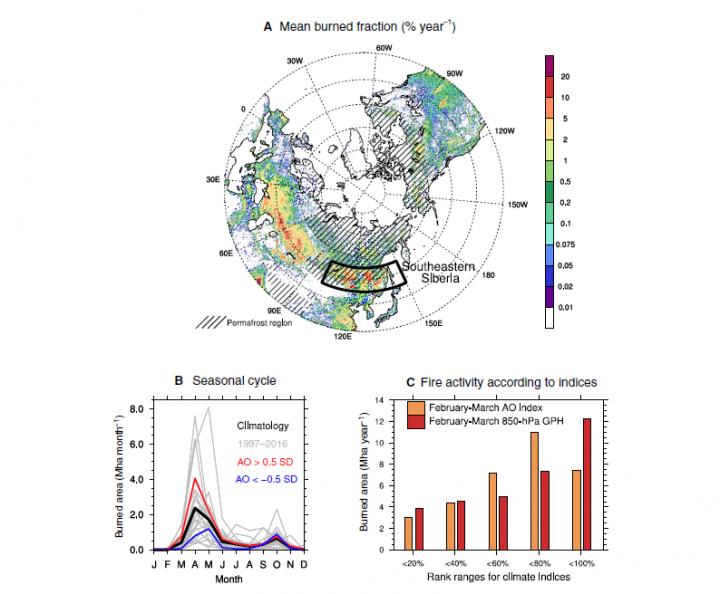
Credit: Jong-Seong Kug (POSTECH)
In November of last year, the wildfire that started in California, U.S.A burned areas that amount about the size of Seoul and destructed over 500 buildings for two weeks. In 2018, six fires started simultaneously in southern California and spread out to the neighboring areas, burning total of 405 km2 with 86 fatalities and 200,000 victims for three days. Also, large-scale wildfires often occur in the northern inland of Russia. The forest fire occurred in July 2018 burned the total area of 3,211 km2 which is 5.3 times bigger than the city of Seoul and, the wildfire, in May 2019, started to spread out and burned down even greater land. So far, extensive wildfires such as the mentioned events are believed to be mostly caused by dry wind, however, the recent study explains that global warming is the kindling that starts such fires.
Jong-Seong Kug, a professor of Division of Environmental Engineering at POSTECH and Jin-Soo Kim, a postdoctoral researcher of University of Edinburgh jointly collaborated with Su-Jong Jeong of Seoul National University, Hotaek Park of Japan Agency for Marine-Earth Science and Technology, and Gabriela Schaepman-Strub of University of Zurich and, they identified a cause of wildfires in the permafrost region of southeastern Siberia which is related to the Artic Oscillation. Their research is published on the international journal, Science Advances on the 8th of January.
Permafrost area, where ground remains frozen for two years straight, spans widely in Siberia, Alaska, and North Europe and it takes about 24% of Northern Hemisphere. It is predicted that permafrost was formed in the end of Ice Age, 11 thousand years ago and believed to have bones of ancient animals, plant roots and five hundred billion tons of carbons buried in it. For this reason, carbon release in this region is as important as the carbon release from human’s use of fossil fuels when predicting climate change.
The research team analyzed the relationship between the changes in weather conditions and forest fires occurred in the permafrost region of southeastern Siberia. In result, they discovered a fact that the atmospheric ring-like structure at the Arctic pole is disrupted and high pressure in this region abnormally increases temperature in winter which brings snowmelt earlier and dried surface, resulting in fire spreading.
Also, they analyzed large-scale atmospheric conditions of southeastern Siberia where most frequent forest fires occur in the Arctic regions. As a result, they found that the amount of burned area is larger one to two months before the Arctic Oscillation than the peak fire activity season in spring (April to May).
Even bigger problem exists when wildfire occurs in the permafrost area. It releases even more amount of carbon than fires in other regions and this increases the amount of carbon in atmosphere which accelerates Arctic warming. This will raise temperature in the Arctic, causing dried surface which then brings fire spreading and the vicious cycle of wildfire begins again.
In addition, one of the critical emissions of Siberian fire is aerosol such as fine dust. When large-scale wildfire occurs in this region, rapidly increased aerosol transports by westerlies and it impacts on air quality in Canada.
There had been reports describing a correlation between the Arctic Oscillation and the Siberian fire activity, however, there was no research that explained precise principle and mechanism before their research. Furthermore, their study can predict spring fire activities by measuring the Arctic Oscillation index in winter which then can help prevent wildfires.
Professor Jong-Seong Kug emphasized the importance of this study, “Permafrost region in Siberia is very important climatologically. Wildfire in this region is not ignited by anthropogenic activities but rather controlled by climate conditions. Looking at these factors, we can then predict fire activities. Recently, Arctic warming in southeastern Siberia has caused fast snowmelts which then can cause extensive amount of carbon release and acceleration of global warming. Therefore, it is critical to develop fire management policy accordingly.”
###
This research was supported by National Research Foundation of Korea under Young Research Exchange Program between Korea and Switzerland which was started in collaboration with University of Zurich when Dr. Jin-Soo Kim was part of this program during his PhD years at POSTECH.
Media Contact
Jinyoung Huh
[email protected]
82-542-792-415
Original Source
http://postech.
Related Journal Article
http://dx.




